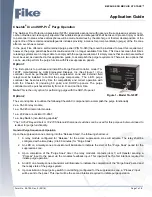
Form No. 06-795, Rev. 0 (02/16)
Page 5 of 8
Figure 6 - Relay Module Configured for “Purge” Operation
5. Select
the
Output
Control
configuration tab (See Figure 7).
6. Select priority Row 1 and set the Activation State option to “No State”; Action Type option to “No Action”; and
Relay State option to “OFF”. This priority row is unused and a placeholder for future use, if desired. The
programmer can move all rows up one row and program the change accordingly.
7. Select priority Row 2 and set the Activation State option to “No State; Action Type option to “Activate on
Multiple Priority Rows Active”; and Relay State option to “ON”.
8. Upon setting the relay action type to “Activate on Multiple Priority Rows Active”, priority row selection fields
will appear at the bottom of the configuration screen. Set Priority Row A to 3 and Priority Row B to 4. Row two
of the Output Control table should indicate Group P3, P4.
9. Select priority Row 3 and set the Activation State option to “Process”; Action Type option to “Activate on
Specific Device”; and Relay State option to “OFF.
10. Upon setting the relay action type to “Activate on Specific Device”, loop and address selection fields will
appear at the bottom of the configuration screen. Set these fields to match the loop and address of the relay
module used for the “Agent Soak” timer (i.e., loop 1, address 8).
11. Select priority row 4 and set the Activation State option to “Process”; Activation Type option to “Activate on
Specific Device”; and Relay State option to “OFF”.
12. Upon setting the relay action type to “Activate on Specific Device”, loop and address selection fields will
appear at the bottom of the configuration screen. Set these fields to match the loop and address of the
monitor module used for the “PURGE” key-switch (i.e., loop 1, address 34).
13. Remaining configuration options should be left at default settings.








